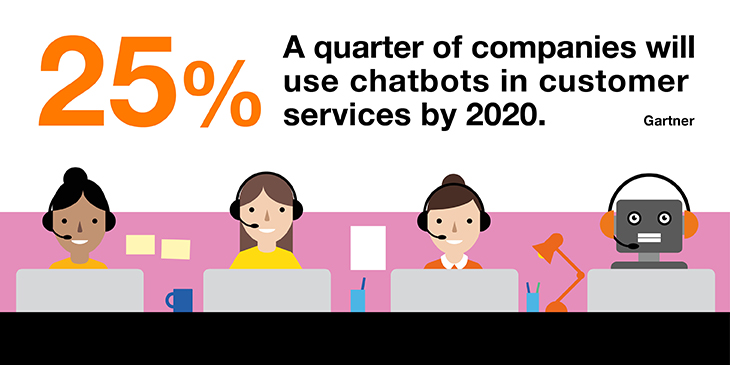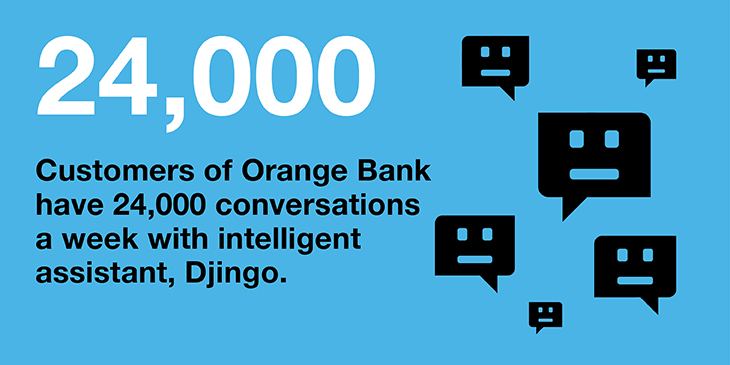Chatbots have very much entered the mainstream. According to Google Trends, searches for the word "chatbot" grew 19 times over the past 5 years, while a HubSpot research report found that 71 percent of people use chatbots to quickly solve their customer queries.
Powering the new conversation
Today, if you want to order an Uber taxi, you have to download an app on your phone, sign up, enter your credit card info, request a driver, select a type of service and finally enter your destination. What you really want is the ability to just say, "I want to go to my office for the cheapest price." That's what bots can deliver: no downloads, no set-ups, always on and available across the various messaging platforms that consumers use to send and receive messages, including Facebook, Slack, WeChat, WhatsApp, or your own websites and apps.
HubSpot research found that 56 percent of people would rather message than call customer services, and 53 percent say they are more likely to shop with businesses they can message. The chatbot has evolved to become a consumer's interface of choice, so much so that it has been given a name – the Conversational User Interface, or CUI. As a result, Gartner predicts that a quarter of companies will use chatbots in customer services by 2020.

Delivering a friction-less customer experience
Orange has worked with major enterprises around the world to develop a wide range of consumer and business process optimization chatbots. These solutions use artificial intelligence (AI) – ranging from basic pattern matching to self-learning – to accelerate and automate customer care, freeing up staff for value-added tasks.
For example, one major chain of DIY stores approached Orange as it wanted to make it easier for shoppers to find products and information on its website. Online retailers typically have large product catalogs that consumers can find overwhelming to navigate. Filters and search tools can be a time-consuming way of trying to find exactly what you're after. A chatbot provides a good approximation of an in-store physical experience. Consumers can interact with the "chatbot shop assistant" who can identify the shopper's need and take them to where they want to go before helping them ring up their choices and complete payment at the checkout.
Meanwhile, Orange Bank in France uses a virtual advisor – or chatbot – called Djingo, powered by IBM Watson, to answer customers' questions. Djingo can be accessed using voice and text via a mobile banking app, smart home speaker or an Orange set-top box remote control. It can even carry out simple banking operations, such as blocking and unblocking a bank card. Djingo uses reinforcement learning to constantly improve its skills and responses over time.
Available 24/7, Djingo conducts almost 24,000 conversations per week, including nearly 20 percent outside normal office hours. For more complicated requests – for example a dispute regarding a payment – Djingo refers the customer to a Customer Relationship Center expert. The integration of a chatbot into an enterprise's omnichannel customer contact center strategy is vital to delivering a seamless customer experience.

Helping the IT help desk
Orange has also developed a chatbot for the International Committee of the Red Cross (ICRC) to automate and accelerate the handling of routine IT help desk requests. The ICRC operates in over 80 countries, helping people in war zones and other high-risk places. The solution is helping the ICRC ensure employees have access to the digital tools they need to do their jobs.
Between 30-50 percent of an IT help desk's support calls are basic, routine inquiries. These can easily be addressed by a chatbot, freeing up staff to handle more complex issues. A bot can even be combined with virtual agents or AI workers to completely resolve an incident, for example handling a password reset request.
Orange has even developed a chatbot for firms using Skype for Business. If an employee experiences a problem on a call, they can use the chatbot to open a ticket and capture real-time network data. This sort of information wouldn't be available to an IT help desk who was asked hours later to investigate and is vital to fully resolving the issue.
For example, the Skype help desk chatbot can identify if the caller was using Wi-Fi, which perhaps had a poor signal, and address the problem. Employees are happier as issues are resolved much more quickly, and over-worked IT help desk agents have more time on their hands to deal with other more complex issues.
Your new digital workers
These chatbots can be categorized into four basic types:
1. Scripted chatbot: This type of basic chatbot uses "pattern matching" to respond to routine questions in a scripted way and looks for key phrases and gives pre-defined responses from a Frequently Asked Questions database.
2. Intent recognition chatbot: An "intent recognition chatbot" features machine learning capabilities and is able to "guess" what the user is requesting, even if it's phrased unexpectedly. The relationships between words are taken into account to extract meaning. The bot is more human-like, able to detect and show emotions.
3. Virtual assistant: A virtual assistant uses more advanced AI to follow a conversation history and recall contextual information for more human-like interactions. It connects to other systems to leverage user data and insights.
4. Virtual agent: A virtual agent can connect to back-end systems and has the ability to make changes and request information using robotic process automation (RPA). It can handle complex dialogs, business processes and security protocols.
Your choice of chatbot will depend on the volume of inquiries you have to deal with, the complexity of the inquiries your business receives and your broader digital business goal.
At the same time, it's important to think about how you balance and blend the use of AI and human engagement to personalize and simplify the customer journey, reducing friction at every point of interaction. Research shows consumers want AI to be human-like in terms of interaction, but they also want to know when they are talking to an AI-enabled system rather than a human. The level of human engagement desired by consumers is directly correlated to the importance of the decision. The more important the decision, the more consumers want humans to be involved.
What is clear is that chatbots have fast become a business imperative. From conversational commerce to help desk heroes – chatbots are here to stay. They play a vital role in augmenting and enhancing the valuable work of your human workforce to boost customer service levels.
Read this IDC whitepaper on the business benefits of CX transformation initiatives, and how robots are transforming the contact center.